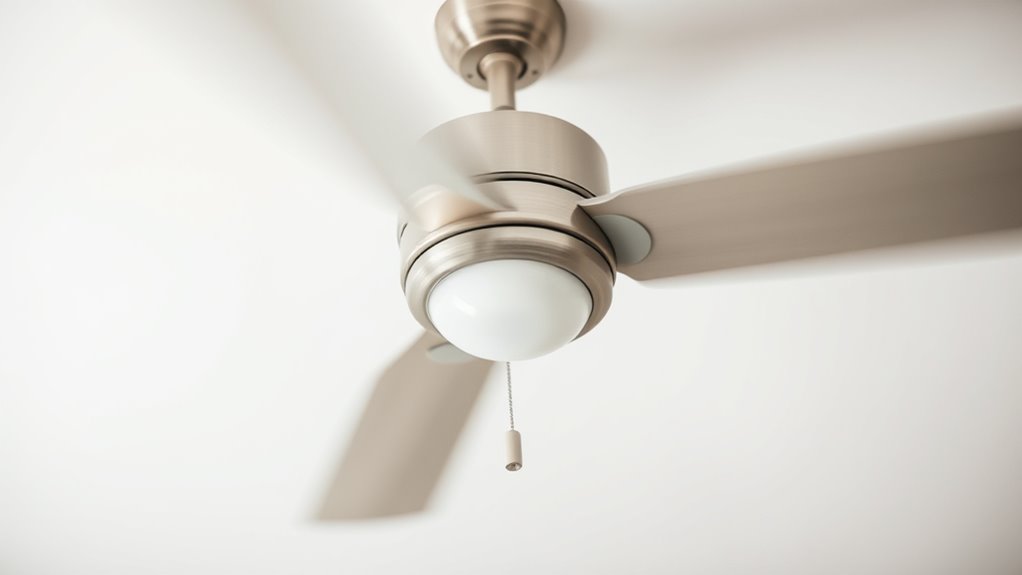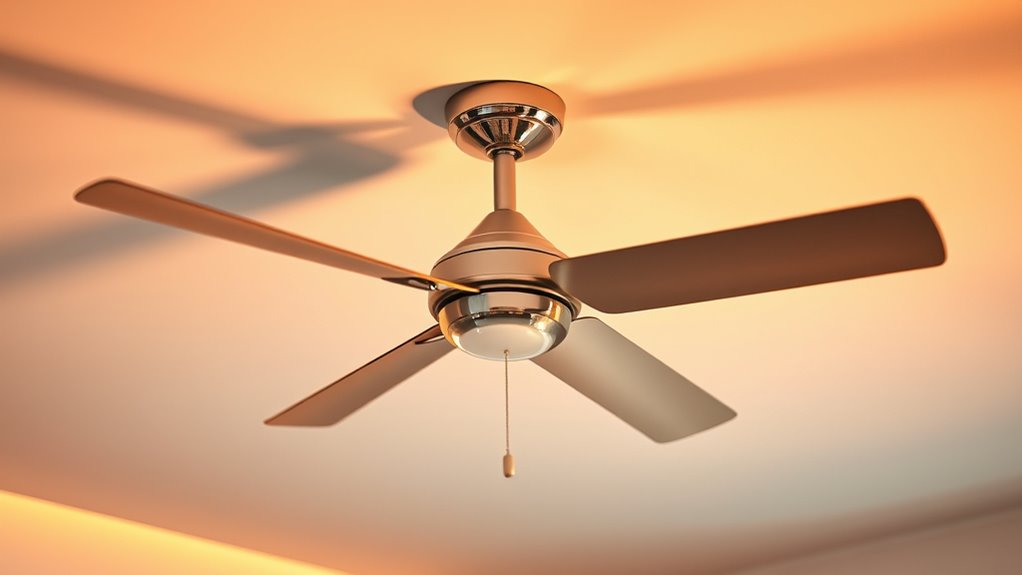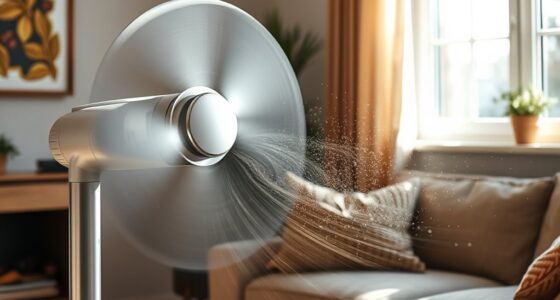To instantly improve your comfort, simply flip the switch on your ceiling fan to change its direction. During warmer months, set it to counterclockwise to create a cooling breeze. In winter, switch it clockwise to circulate warm air near the ceiling. This quick adjustment helps you stay comfortable all year and can even save energy. Keep going to discover more tips on making the most of your ceiling fan’s benefits.
Key Takeaways
- Flipping the fan switch adjusts blade rotation, controlling airflow direction for seasonal comfort.
- Counterclockwise creates a cooling breeze, ideal for summer, while clockwise circulates warm air in winter.
- Changing fan direction is quick and simple, offering immediate comfort without additional heating or cooling.
- Properly setting the fan direction reduces energy costs by enhancing heating or cooling efficiency.
- Regularly adjusting the switch ensures optimal airflow, comfort, and energy savings year-round.

Ever wonder how the direction your ceiling fan spins can affect your comfort and energy bills? It’s a simple switch many overlook, yet it has a big impact on both how you feel and how much you spend. When you flip that switch, you can instantly improve your room’s energy efficiency and even enhance your decor. Understanding the right fan direction for different seasons isn’t just a matter of comfort; it’s a smart way to save money and elevate your space’s style.
During the warmer months, setting your ceiling fan to spin counterclockwise creates a breeze that cools you down. This airflow helps evaporate sweat from your skin, making you feel cooler without cranking the air conditioning. By doing so, you reduce your reliance on AC, which can substantially cut your energy bills. The fan’s blades move air efficiently, creating a wind-chill effect that keeps you comfortable while using less electricity. Plus, a well-spinning fan can serve as a decorative element—adding a modern or traditional touch that complements your room’s aesthetic. Whether your fan has sleek, minimalist blades or ornate detailing, the right direction can make your decor pop while serving its functional purpose.
Setting your ceiling fan to spin counterclockwise cools you down and reduces energy bills with stylish efficiency.
Come winter, flipping the switch to clockwise rotation makes your ceiling fan work in reverse. Instead of creating a breeze, it gently circulates warm air trapped near the ceiling down into the living space. This helps maintain a consistent temperature without over-relying on your heater, which can save you money on energy bills. It’s a subtle change that enhances your comfort by preventing cold spots and drafts. Additionally, a ceiling fan rotating clockwise can add a sophisticated touch to your decor, especially if it complements your room’s color scheme and design style. Some fans come with reversible blades or sleek finishes that can elevate the overall look of your space.
Getting into the habit of adjusting your ceiling fan’s direction seasonally is a quick, cost-effective way to optimize both comfort and energy efficiency. It takes just seconds to flip that switch, but the benefits last all year. Not only do you feel more comfortable, but you also cut down on energy waste, which helps your wallet and the environment. And with the right fan direction, your space can look more polished and inviting, seamlessly blending function and decor. So next time you’re feeling a little too warm or chilly, remember: a simple switch can make all the difference. Proper fan operation can significantly boost your home’s energy savings and comfort.
Frequently Asked Questions
Can Changing Fan Direction Save Energy During Different Seasons?
Yes, changing the fan direction can improve energy efficiency and boost seasonal savings. In summer, set your ceiling fan to spin counterclockwise to create a cooling breeze, reducing your air conditioning use. In winter, switch it clockwise to circulate warm air without extra energy costs. This simple adjustment helps you save on energy bills year-round while maintaining comfort, making your home more efficient through seasonal savings.
How Do I Tell if My Ceiling Fan Has a Reversible Motor?
Ever wonder how to tell if your ceiling fan has a reversible motor? Check the motor labeling or look for a switch on the fan body itself. Many reversible fans also come with a remote control that allows you to change direction easily. If you’re still unsure, consult the fan’s manual or manufacturer’s website. Having a reversible motor helps you switch seasons effortlessly, saving energy and increasing comfort.
Is There a Safety Risk When Flipping the Ceiling Fan Switch?
Flipping your ceiling fan switch is generally safe if you follow proper fan safety procedures. Make sure the fan is turned off before switching directions to avoid electrical hazards or injury. If the fan has a reversible motor, switching the direction won’t cause electrical issues. Always inspect the switch and wiring for damage, and avoid flipping it if you notice any electrical hazards. Regular maintenance helps guarantee safe operation.
How Often Should I Change the Fan Direction for Optimal Comfort?
Imagine your home as a cozy symphony where comfort flows seamlessly. You should change your fan direction seasonally—usually in spring and fall—to optimize comfort. During summer, set it clockwise for a breeze, and in winter, switch to counterclockwise to push warm air down. Regular fan maintenance guarantees smooth operation, and adjusting the fan direction isn’t needed often—just twice a year or as needed for seasonal adjustment.
Can Incorrect Fan Direction Cause Damage to the Fan?
Incorrect fan direction generally won’t damage your ceiling fan, but improper use can cause wear over time. Poor fan blade maintenance or flawed ceiling fan installation might lead to wobbling or noise, which could eventually harm the motor. To prevent issues, regularly check your fan blades and ensure proper installation. Properly flipping the switch for the season maintains efficiency, avoiding unnecessary strain that could damage your fan.
Conclusion
Now that you know how a simple switch can transform your comfort, it’s surprising how something so small makes such a big difference. Flip the fan’s direction, and you’ll instantly feel cooler or warmer — a clever trick that saves energy and money. It’s easy to overlook, yet this tiny action can change your room’s atmosphere completely. Sometimes, the smallest adjustments bring the biggest relief, proving that comfort is just a switch away.









